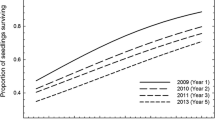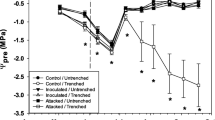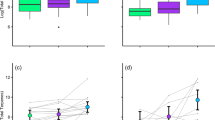Summary
Neodiprion autumnalis (Smith) larvae were caged for two successive years on root-trenched, watered, and untreated ponderosa pine (Pinus ponderosa Doug. ex Laws.) to determine effects of host moisture stress on larval feeding. Levels of moisture stress (as measured by the Scholander pressure chamber) differed significantly among treatment levels during 1984 and 1985 larval feeding periods. Differences in larval feeding success were not detected in 1984. In 1985, however, larvae on trenched (stressed) trees clipped and rejected more foliage, consumed more needles, had lower pupal weights, lower survival, and a longer feeding period than larvae on watered or untreated trees. Frass production did not differ among treatment levels. The length of the feeding period was shorter for larvae on watered trees than for larvae on untreated trees, but other measures of feeding success did not significantly differ between watered and untreated trees.
Similar content being viewed by others
References
Averill RD, Fowler RF (1973) US Forest Service Northeast Area State Private Forestry Progress Report 1972. S-7-73, in Mattson, WJ and ND Addy 1975. Phytophagous insects as regulators of forest primary production. Science 190:515–522
Averill RD, Wilson WF, Fowler RF (1982) Impact of the redheaded pine sawfly (Hymenopter: Diprionidae) on young red pine plantations. Great Lakes Entomol 15:65–91
Baldwin VC, Barney CW (1976) Leaf water potential in planted ponderosa and lodgepole pines. Forest Science 22:344–350
Beatty J (1980) Forest insect and disease conditions in the Southwest-1979. USDA Forest Service, Forest Insect and Disease Management, Southwestern Region, R-3, pp 80–87
Berenays EA, Woodhead S (1982) Plant phenols utilized as nutrients by a phytophagous insect. Science 216:201–203
Cates RG, Redak RA, Henderson CB (1983) Patterns in defensive natural product chemistry: Douglas-fir and western spruce budworm interactions. In: Hedin P (ed) Plant resistance to insects. American Chemical Society, Washington, DC, pp 1–19
Chadda IC, Arora R (1982) Influence of water stress in the host plant on the mustard aphid Lipaphis erysimi (Kattenbach). Entomon 7:75–78
Cleary BD, Zaerr JB (1980) Water status and carbon dioxide exchange studies; pressure chamber techniques for monitoring and evaluating seedling water status. NZJ For Scie 10(1):133–141
Cline RG, Campbell GS (1976) Seasonal and diurnal water relations of selected forest species. Ecology 57:367–373
Coley PD (1983) Herbivory and defensive characteristics of tree species in a lowland tropical forest. Ecol Monogr 53:209–233
Dahisten DL (1961) Life history of a pine sawfly, Neodiprion sp, at Willits, California (Hymenoptera: Diprionidae). Canad Entomol 93:183–195
Dahlsten DL (1961) Some biological attributes of sawflies in the Neodiprion fulviceps complex in a brushfield pine plantation. Canad Entomol 98:1055–1083
Dahlsten DL (1966) Preliminary life tables for pine sawflies in the Neodiprion fulviceps complex (Hymenoptera: Diprionidae). Ecology 48:275–289
Feeny P (1970) Seasonal changes in oak leaf tannins and nutrients as a cause of spring feeding by winter moth caterpillars. Ecology 51:565–581
Fox L, MaCauley B (1977) Insect grazing on Eucalyptus in response to variation in leaf tannins and nitrogen. Oecologia (Berlin) 26:145–162
Hanski I, Parviainen P (1985) Cocoon predation by small mammals, and pine sawfly population dynamics. Oikos 45:125–136
Hinckley TM, Ritchie GA (1972) Reaction of mature Abies seedlings to environmental stresses. Trans M Acad Scie 6:24–37
Hodges JD, Lorio Jr PL (1975) Moisture stress and composition of oleoresin in loblolly pine. For Scie 21:283–290
Kapler JE, Benjamin DM (1960) The biology and ecology of the red-pine sawfly in Wisconsin. For Scie 6:253–268
Knerer G, Atwood CE (1973) Diprionid sawflies: polymorphism and speciation. Science 179:1090–1099
Kozlowski TT (1968) Water deficits and plant growth, vol 2. Academic Press, New York London
Kramer PJ, Kozlowski TT (1979) Physiology of woody plants. Academic Press, New York, New York
Lucht DD (1968) Forest insect conditions in the US,-1967. USDA Forest Service. Forest Pest Control Status Report. Southwestern Region, p 25
Mattson WJ, Addy ND (1975) Phytophagous insects as regulators of forest primary production. Science 190:515–522
McLeod JM (1970) The epidemiology of the swaine jack-pine sawfly, Neodiprion swainei Middleton. For Chron 46:125–133
McMurray TI (1980) Effects of drought stress induced changes in host foliage quality on the growth of two forest insect pests. MS thesis, University of New Mexico, p 56
McNeil S, Southwood TRE (1978) The role of nitrogen in the development of insect and plant relationships. In: harbourne JB (ed). Biochemical aspects of plant animal coevolution. Academic Press, London, pp 77–98
Miller ML, James MS (1972) General soil map, Coconino County, Arizona. US Dept of Agriculture Soil Conservation Service
Murphy EM, Ferrell WK (1982) Diurnal and seasonal changes in leaf conductance, xylem water potential, and abscisic acid of Douglas-fir (Pseudotsuga menziesii Mirb Franco) in five habitat types. For Scie 28:627–638
Niemala P, Mannila R, Namtsala P (1982) Deterrent in Scots pine, Pinus sylvestris, influencing feeding behaviour of the larvae of Neodiprion sertifer (Hymenoptera: Diprionidae). Ann Entomol of Finland 48:57–59
Raffa KF, Berryman AA (1982) Physiological differences between lodgepole pine resistance and susceptibility to the mountain pine beetle and associated microorganisms. Environ Entomol 11:486–492
Raupp MJ (1985) Effects of leaf toughness on mandibular wear of the leaf beetle Plagiodera versicolora. Ecol Entomol 10:73–79
Raupp MJ, Denno RF (1984) The suitability of damaged willow leaves as food for the leaf beetle, Plagiodera versicolora. Ecol Entomol 9:443–448
Rausher MD (1981) Host plant selection by Battus philenor butter-flies: the role of predation, nutrition and plant chemistry. Ecol Monogr 51:1–20
Rhoades DF (1979) Evolution of plant chemical defense against herbivores. In: Rosenthal GA, Janzen DH (eds) Herbivores: Their interaction with secondary plant metabolites. Academic Press, New York, pp 3–53
Richter VH (1974) Erhöhte Saugspannungswerte und morphologische Veränderungen durch transversale Einschnitte in einem Taxus-Stamm. Flora 163:291–309
Running SW (1976) Environmental control of leaf water conductance in conifers. Canad J For Res 6:104–112
Saunier RE, Jull HM, Ehrenreich JH (1968) Aspects of the drought tolerance in creosote bush (Larrea divaricata). Plant Physiol 43:401–404
Scholander DPF, Fammel HT, Bradstreet ED, Hemmingsen EA (1965) Sap pressure in vascular plants. Science 148:339–346
Scriber JM, Feeny P (1979) Growth of herbivorous caterpillars in relation to feeding specialization and to the growth form of their food plants. Ecology 60:829–850
Seiler JR, Johnson JD (1985) Photosynthesis and transpiration of loblolly pine seedlings as influenced by moisture-stress conditioning. For Scie 31:742–749
Smith DR, Wagner MR (1986) Recognition of two species in the pine feeding “Neodiprion fulviceps complex” (Hymenoptera: Diprionidae) of the western United States. Proceedings of the Entomological Society of Washington 88(2):215–220
Southwood TRE (1973) The insect/plant relationship, an evolutionary perspective. Symp Roy Entomol Soc, London 6:3–30
Tanton MT (1962) The effect of leaf “toughness” on the feeding of larvae of the mustard beetle Phaedon cochleariae Fab. Entomol Exp Appl 5:74–78
Temple AS (1981) Field studies of the relationship between herbivore damage and tannin concentration in Bracken (Pteridium aquilinum Kuhn). Oecologia (Berlin) 51:97–106
Thames JL (1963) Needle variation in loblolly pine from four geographic seed sources. Ecology 44:168
Thielges BA (1968) Altered polyphenol metabolism in the foliage of Pinus sylvestris associated with European pine sawfly attack. Canad J Bot 46:724–725
Wagner MR (1986) Influence of moisture stress and induced resistance in ponderosa pine, Pinus ponderosa Dougl ex Laws on the pine sawfly, Neodiprion fulviceps (Cresson) complex. For Ecol Manag 15:43–53
Wagner MR, Blake EA (1983) Western spruce budworm consumption — effects of host species and foliage chemistry. In: Proceedings-Forest Defoliator-Host interactions: A comparison between gypsy moth and spruce budworm. US Forest Service General Technical Report NE-85, pp 49–54
Wagner MR, mcCullough DG, DiMatteo JM (1986) Life history of Neodiprion fulviceps (Cresson) (Hymenoptera: Diprionidae): a ponderosa pine feeding sawfly. Proceedings of the Entomological Society of Washington 88(2):221–226
Wambolt CL (1973) Conifer water potential as influenced by stand density and environmental factors. Canad J Bot 51:2333–2337
Waring RH, Cleary BD (1967) Plant moisture stress: evaluation by pressure bomb. Science 155:1248–1254
Webb JW, Franklin RT (1978) Influence of phloem moisture on brood development of the southern pine beetle (Coleoptera: Scolytidae). Environm Entomol 7:405–410
White TCR (1969) An index to measure weather induced stress of trees associated with outbreaks of Psyllids in Australia. Ecology 50:905–909
White TCR (1974) A hypothesis to explain outbreaks of looper caterpillars with special reference to populations of Selidosema sauvis in a plantation of Pinus radiata in New Zealand. Oecologia (Berlin) 16:279–301
White TCR (1976) Weather, food and plagues of locusts. Oecologia (Berlin) 22:119–134
White TCR (1984) The abundance of invertebrate herbivores in relation to the availability of nitrogen in stressed food plants. Oecologia 63:90–105
Wilson LF (1977) A guide to insect injury of conifers in the Lake States. US Forest Service Agricultural Handbook 501
Zar JH (1984) Biostatistical analysis. Second ed. Prentice-Hall Inc, Inglewood Cliff, New Jersey
Author information
Authors and Affiliations
Rights and permissions
About this article
Cite this article
McCullough, D.G., Wagner, M.R. Influence of watering and trenching ponderosa pine on a pine sawfly. Oecologia 71, 382–387 (1987). https://doi.org/10.1007/BF00378711
Received:
Issue Date:
DOI: https://doi.org/10.1007/BF00378711




